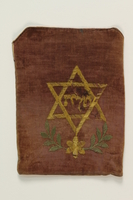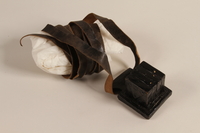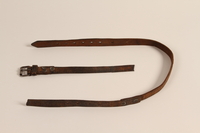Overview
- Brief Narrative
- Hand tefillin given to Idek Smolarz, 25, while recovering in a hospital in Wels, Austria, after his liberation on May 5, 1945. Idek received a tefillin set from another patient, a Czech boy who kept the tefillin with him while working for the Germans digging fox holes. In May 1942, Idek and his oldest brother Solomon were sent to Krakow-Kostrze labor camp, and then to Krakow-Płaszów, where they were joined by their father Meyer. Their mother and siblings were rounded up in Skala, Poland. In summer 1943, Meyer died of typhus. In early 1944, Idek and Solomon were sent to Auschwitz I. In March, the brothers were separated when Idek was sent to Sosnowitz II slave labor camp. In late 1944 or early 1945, Idek was sent on a death march to Mauthausen concentration camp in Austria. He was reunited with Solomon, but in March, Idek was sent to Wien-Hinterbruehl slave labor camp and Solomon to Melk. Idek was sent back to Mauthausen that month and found Solomon and their brother Leon. In April, Idek, Solomon, and Leon were sent on a death march to Gunskirchen, where they were liberated on May 5, 1945. They stayed in a hospital in Wels, then lived in Bindermichl displaced persons camp until their 1949 immigration to the United States. Idek’s mother, three sisters, younger brother, niece, nephew, and most of his extended family were killed during the Holocaust.
- Date
-
received:
after 1945 May
- Geography
-
use:
Czechoslovakia
received: Wels (Austria)
- Credit Line
- United States Holocaust Memorial Museum Collection, Gift of Edward Smolarz, in memory of his beloved grandparents Smolarz, Allerhand, and Langsam, his parents Meyer and Rosalia, his sisters Sara, Hanah, and Rifka, his brother, Samuel, and all victims of the Holocaust
- Contributor
-
Subject:
Edward Smolarz
- Biography
-
Idek Smolarz was born on March 31, 1920, in Krzeszowice, Poland, to an Orthodox Jewish couple, Meyer and Rosalia Allerhand-Langsam Smolarz. Idek had six siblings: Solomon, born on November 28, 1911, Sara, born on September 28, 1913, Hanah, also called Ann, born on July 15, 1915, Leon, born on September 17, 1917, Samuel, born on January 19, 1925, and Rifka, born on December 4, 1929. Their father Meyer was born in 1888 in Chmielnik, to David and Esther Lefkovich. He had two siblings. Meyer was a sheet metal mechanic. He changed the family name to Smolarz to avoid antisemitic persecution. Idek’s mother Rosalia was born circa 1889 in Trzebinia, to David Shalom and Gitl Allerhand-Langsam. Rosalia had four siblings. Idek’s family was observant and attended services on Friday nights. Meyer went to the synagogue every morning to pray. Idek attended public school for seven years. The Polish children beat up the Jews and taunted them. After school, Idek worked with his father in Krzeszowice. In 1936, Idek began working in Krakow as an iron worker for Adolf Horszowski, who married Idek’s sister Sara. Sara and Adolf had a daughter, Esther, in December 1938. Idek’s sister Hanah married Tulek Rozenbaum, a furrier. They lived in Krakow and had a son, Yakow. Idek’s older brothers, Solomon and Leon, were in the Polish Army.
On September 1, 1939, Germany invaded Poland. The next day, Idek, Meyer, and Samuel fled and walked for almost 40 miles before being surrounded by German soldiers. They walked back to Krakow and went to Sara’s house. Idek’s mother Rosalia and younger sister Rifka were also there. After a few weeks, Solomon and Leon came to Krakow after surrendering to the Soviet Army. Sara’s husband Adolf was also in the Polish Army and surrendered to the Soviets, but stayed in the Soviet Union. Idek’s family returned to Krzeszowice. Idek was forced to work for the Germans, first in a stone quarry, then in the city hall. Idek’s sister Sara and her daughter Esther eventually came to live with them. In 1940, all Jews were forced to leave Krzeszowice. Idek and his family moved to Raclawice. Idek, Solomon, and Samuel worked with Meyer in sheet metal, receiving food in exchange for labor. Leon lived in a different town and was a barber. In early 1942, Samuel was taken to Krakow-Płaszów labor camp. In about May, Idek and Solomon were taken to Krakow-Kostrze labor camp. They dug gutters in the street for water runoff. Idek went to the Krakow ghetto and found Samuel. He helped Samuel leave Krakow and return to their family. They were forced to leave Raclawice and were living in Skala. In fall 1942, Idek and Solomon were transferred to Krakow-Płaszów. Their father Meyer was eventually sent to the camp. The Jews in Skala had been rounded up and Meyer was sent to the camp because he was a sheet metal mechanic. Idek, Solomon, and Meyer worked at the railroad station, Idek as an iron worker and Solomon and Meyer as sheet metal mechanics. Idek’s sister Hanah came to the railroad station to see Meyer. She and her son Yakow had been living under false papers, but someone had seen that Yakow was circumcised and threw them out. Meyer was unable to help his daughter and she went to the Krakow ghetto. An acquaintance from Krzeszowice came to Krakow-Płaszów and told them that the Jews who were rounded up were being killed. Idek, Solomon, and Meyer believed that the rest of their family were dead. Circa July 1943, Meyer, Idek, and Solomon caught typhus during an outbreak and were sent to the hospital. Meyer was released from the hospital, but died later that day.
In early 1944, Idek was selected to go to Auschwitz I concentration camp with 250 laborers. Solomon was not selected, but convinced a kapo to let him go too. They were forced to strip and shower and were issued striped uniforms. Idek was assigned prisoner number 174250 and Solomon number 174259. The group was placed in quarantine. Idek volunteered to help two Polish prisoners paint, and was given food. After two weeks in quarantine, they were assigned to labor groups. Solomon was a sheet metal mechanic and Idek was a gardener. He was beaten by the kapo, so Solomon got him a different assignment at the lumber yard, sorting boards. In about March, Idek was selected to go to Sosnowitz II labor camp, a nearby subcamp of Auschwitz. He was separated from Solomon. Idek constructed the barbed wire fence around the inmates’ housing and cut down the trees and shrubbery around the camp. He then worked in a factory that made guns and filed the threads inside gun barrels. One of the Polish laborers in the factory gave Idek a book of services for the High Holidays. Idek and the other prisoners used the book to have secret High Holidays services in September.
In December 1944 or January 1945, Idek was sent on a death march for several days. Weak prisoners who could not walk were shot. Idek got very sick and could not keep walking, but two friends held him up. Idek tried to escape at night, but was unsuccessful. The prisoners were put on trains and taken to Mauthausen concentration camp in Austria, arriving on February 2. Idek was assigned prisoner number 125660. He was kept in quarantine, then released and issued clothing. Idek found Solomon in the camp, who was assigned prisoner number 117289. Idek worked carrying heavy stones at the stone quarry. On March 7, Idek was sent to Wien-Hinterbruehl labor camp near Moelding. They made missiles in an underground factory. After two weeks, he was sent on a death march to Mauthausen. In Mauthausen, Idek found his brother Leon. Leon had been sent to Krakow-Płaszów in August 1942 and assigned prisoner number 11660, then sent to Mauthausen in August 1944, where he was assigned prisoner number 87062. On August 23, he was sent to Gusen labor camp. Idek and Leon were reunited with Solomon, who had been sent from Mauthausen to Melk labor camp, then Gusen labor camp. Circa April, the brothers were sent on a death march to Gunskirchen concentration camp, a subcamp of Mauthausen. Gunskirchen was very crowded and the prisoners were given no food. On May 5, Idek and his brothers were liberated. The war ended when Germany surrendered on May 7.
Idek, Solomon, and Leon left the camp and stayed with an Austrian farmer. Solomon caught typhus so the farmer made them leave. The brothers were picked up by American troops and taken to a hospital in Wels. In 1946, they went to Linz-Bindermichl displaced persons camp. Idek learned that the rest of his family was killed in the Holocaust. His brother Samuel had escaped the round up in Skala, but returned to the Krakow ghetto to find his girlfriend. He was killed in a concentration camp. Idek’s mother Rosalia, his sisters Rifka and Sara, and Sara’s daughter Esther were killed in Majdanek. Hanah and her son Yakow died in the Krakow ghetto. All of Idek’s paternal and maternal aunts and uncles were killed. On January 7, 1949, Idek, Solomon, Solomon’s wife Ela, and their three year old daughter Perla sailed from Hamburg on the SS Marine Flasher, arriving in Boston on January 17. Idek changed his name to Edward and Solomon to Bernard. Leon arrived in Boston in November. The brothers settled in Springfield, Massachusetts. On June 6, 1954, Edward married Janice Marilyn Morstein (1931-1997). The couple had two children. In 1962, they moved to Baltimore, Maryland. Leon, 47, died on June 4, 1965. Bernard, 66, died on October 6, 1981. Edward, 92, died on January 30, 2013.
Physical Details
- Classification
-
Jewish Art and Symbolism
- Category
-
Jewish ceremonial objects
- Object Type
-
Tefillin (lcsh)
- Physical Description
- Well-worn hand tefillin with a square, black painted, leather box [batim] with smooth sides. The box is centered on a black painted, square, 5 layered leather platform, sewn together with gut from kosher animals [giddin]. The platform has a triangular, notched back with an opening through which a worn, long, looped, black painted leather strap [retzu’ot] is threaded. The underside of the strap is unfinished. The box should hold a parchment scroll [parshiyot] inscribed with 4 Hebrew prayers. The paint has worn off the strap and part of the sides and edges of the box. The platform is bent and the box is warped. The strap is neatly coiled around 1 side of the platform. The head tefillin is 1993.156.1.3ab.
- Dimensions
- overall: Height: 2.125 inches (5.398 cm) | Width: 2.375 inches (6.032 cm) | Depth: 3.500 inches (8.89 cm)
- Materials
- overall : leather, paint, parchment, gut, ink
Rights & Restrictions
- Conditions on Access
- No restrictions on access
- Conditions on Use
- No restrictions on use
Keywords & Subjects
- Topical Term
- Concentration camp inmates--Austria--Biography. Concentration camp inmates--Poland--Biography. Holocaust survivors--Baltimore (Md.)--Biography. Holocaust, Jewish (1939-1945)--Poland--Personal narratives. Jewish refugees--Austria--Biography. Slave labor--Austria--Biography. World War, 1939-1945--Conscript labor--Personal narratives.
Administrative Notes
- Legal Status
- Permanent Collection
- Provenance
- The tefillin was donated to the United States Holocaust Memorial Museum in 1993 by Edward Smolarz.
- Funding Note
- The cataloging of this artifact has been supported by a grant from the Conference on Jewish Material Claims Against Germany.
- Record last modified:
- 2022-07-28 18:22:12
- This page:
- https://collections.ushmm.org/search/catalog/irn7288
Download & Licensing
In-Person Research
- By Appointment
- Request 21 Days in Advance of Visit
- Plan a Research Visit
- Request to See This Object
Contact Us
Also in Edward Smolarz collection
The collection consists of a handmade belt and a tefillin set and pouch relating to the experiences of Idek (later Edward) Smolarz during the Holocaust in Auschwitz I concentration camp and after the Holocaust in Wels, Austria.
Date: 1944-1945

Embroidered brown tefillin bag used by a Jewish Polish man
Object
Tefillin pouch given Idek Smolarz, 25, while recovering in a hospital in Wels, Austria, after his liberation on May 5, 1945. Idek received a tefillin set from another patient, a Czech boy who kept the tefillin with him while working for the Germans digging fox holes. In May 1942, Idek and his oldest brother Solomon were sent to Krakow-Kostrze labor camp, and then to Krakow-Płaszów, where they were joined by their father Meyer. Their mother and siblings were rounded up in Skala, Poland. In summer 1943, Meyer died of typhus. In early 1944, Idek and Solomon were sent to Auschwitz I. In March, the brothers were separated when Idek was sent to Sosnowitz II slave labor camp. In late 1944 or early 1945, Idek was sent on a death march to Mauthausen concentration camp in Austria. He was reunited with Solomon, but in March, Idek was sent to Wien-Hinterbruehl slave labor camp and Solomon to Melk. Idek was sent back to Mauthausen that month and found Solomon and their brother Leon. In April, Idek, Solomon, and Leon were sent on a death march to Gunskirchen, where they were liberated on May 5, 1945. They stayed in a hospital in Wels, then lived in Bindermichl displaced persons camp until their 1949 immigration to the United States. Idek’s mother, three sisters, younger brother, niece, nephew, and most of his extended family were killed during the Holocaust.

Head tefillin worn by a Polish Jewish man
Object
Head tefillin given to Idek Smolarz, 25, while recovering in a hospital in Wels, Austria, after his liberation on May 5, 1945. Idek received a tefillin set from another patient, a Czech boy who kept the tefillin with him while working for the Germans digging fox holes. In May 1942, Idek and his oldest brother Solomon were sent to Krakow-Kostrze labor camp, and then to Krakow-Płaszów, where they were joined by their father Meyer. Their mother and siblings were rounded up in Skala, Poland. In summer 1943, Meyer died of typhus. In early 1944, Idek and Solomon were sent to Auschwitz I. In March, the brothers were separated when Idek was sent to Sosnowitz II slave labor camp. In late 1944 or early 1945, Idek was sent on a death march to Mauthausen concentration camp in Austria. He was reunited with Solomon, but in March, Idek was sent to Wien-Hinterbruehl slave labor camp and Solomon to Melk. Idek was sent back to Mauthausen that month and found Solomon and their brother Leon. In April, Idek, Solomon, and Leon were sent on a death march to Gunskirchen, where they were liberated on May 5, 1945. They stayed in a hospital in Wels, then lived in Bindermichl displaced persons camp until their 1949 immigration to the United States. Idek’s mother, three sisters, younger brother, niece, nephew, and most of his extended family were killed during the Holocaust.

Brown leather belt secretly made by a Polish Jewish concentration camp inmate
Object
Brown leather belt secretly made and worn by Idek Smolarz, 23, while imprisoned in Auschwitz I concentration camp from January to March 1944. Idek cut two leather straps off a German machine gun stand and his brother Solomon riveted them together to make him a belt. In May 1942, Idek and his oldest brother Solomon were sent to Krakow-Kostrze labor camp, and then to Krakow-Płaszów, where they were joined by their father Meyer. Their mother and siblings were rounded up in Skala, Poland. In summer 1943, Meyer died of typhus. In early 1944, Idek and Solomon were sent to Auschwitz I. In March, the brothers were separated when Idek was sent to Sosnowitz II slave labor camp. In late 1944 or early 1945, Idek was sent on a death march to Mauthausen concentration camp in Austria. He was reunited with Solomon, but in March, Idek was sent to Wien-Hinterbruehl slave labor camp and Solomon to Melk. Idek was sent back to Mauthausen that month and found Solomon and their brother Leon. In April, Idek, Solomon, and Leon were sent on a death march to Gunskirchen, where they were liberated on May 5, 1945. They stayed in a hospital in Wels, then lived in Bindermichl displaced persons camp until their 1949 immigration to the United States. Idek’s mother, three sisters, younger brother, niece, nephew, and most of his extended family were killed during the Holocaust.



